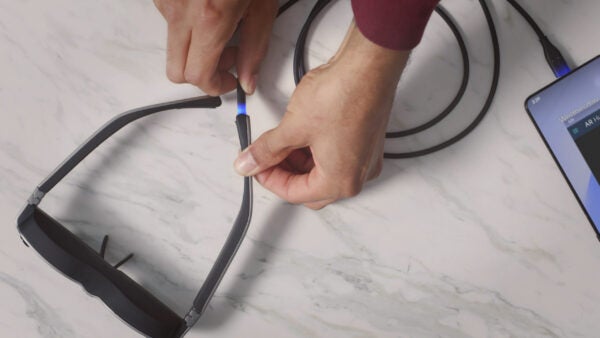
Chipmaker Qualcomm has unveiled a reference design for its latest augmented reality (AR) glasses that will allow the user to anchor virtual screens to their environment.
The XR1 AR Smart Viewer platform is based on Qualcomm’s Snapdragon central processing unit and sees the glasses tethered to a smartphone or PC using a USB-C cable.
It means that perception and display processing takes place in the AR glasses, while rendering takes place on the connected device. By sharing the computing workload between two devices, Qualcomm says it can offer “significant performance features” and additional use cases aimed at both enterprises and consumers.
This includes the ability to launch multiple smartphone applications into the user’s environment and pin them to objects in the room.
Qualcomm added that the split-processing setup results in a 30% overall power reduction. It offers support for an 8GB RGB camera that comes with image stabilisation on the AR glasses.
The dual monochrome cameras also enable head and hand tracking, along with gesture recognition to detect swipes and other hand movements to control the display.
How well do you really know your competitors?
Access the most comprehensive Company Profiles on the market, powered by GlobalData. Save hours of research. Gain competitive edge.

Thank you!
Your download email will arrive shortly
Not ready to buy yet? Download a free sample
We are confident about the unique quality of our Company Profiles. However, we want you to make the most beneficial decision for your business, so we offer a free sample that you can download by submitting the below form
By GlobalDataIt also boasts six degrees of freedom (6DoF), which allow a greater range of movement while using the glasses and interacting with the environment.

“The Snapdragon XR1 AR smart viewer marks a new chapter for our reference design portfolio and a big step in the evolution of AR viewers,” said Hugo Swart, vice president and general manager of XR, Qualcomm Technologies.
“AR simple viewers showcased viewers as an accessory to a smartphone. Now, AR smart viewers allow us to move some processing to the glass, to expand the possibilities of use cases, applications and immersion – this reference design is the first step in our roadmap to help scale the AR industry.”
The reference design – or blueprint – is intended for other manufacturers to build their own AR hardware on top of.
Lenovo has already embraced the Snapdragon XR1 platform for its ThinkReality A3 glasses, an enterprise-focused product that come to market in mid-2021.
Microsoft, which sells its HoloLens mixed reality smart glasses, said it was looking to bring its Azure mixed reality services “towards this ever-expanding ecosystem of Snapdragon-based mixed reality endpoints”.
The next step in Qualcomm’s AR roadmap is to make a wireless design that still shares computational workloads between a device and the glasses, but without the cable to tether it.
Its eventual goal is for all processing, rendering and computation to take place on an AR headset connected to a 5G network. Last year it revealed a reference design for this purpose, the Snapdragon XR2.
Read more: MedCognition: How AR goggles are training first responders







